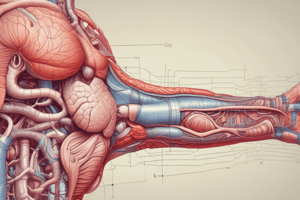Podcast
Questions and Answers
What is the purpose of mechanical digestion in the mouth, and how does it increase the surface area of food?
What is the purpose of mechanical digestion in the mouth, and how does it increase the surface area of food?
Mechanical digestion breaks down large particles of food into smaller particles, increasing the surface area to volume ratio, making it easier for chemical digestion to take place.
What is mastication, and what is its role in the digestive process?
What is mastication, and what is its role in the digestive process?
Mastication is the process of chewing food, which breaks down large particles into smaller ones, creating a bolus, making it easier to swallow.
What is the role of salivary amylase in the mouth, and what is the result of its action on starch?
What is the role of salivary amylase in the mouth, and what is the result of its action on starch?
Salivary amylase breaks down starch into maltose, partially digesting carbohydrates.
What is peristalsis, and how does it facilitate the movement of food through the digestive system?
What is peristalsis, and how does it facilitate the movement of food through the digestive system?
What are the two types of muscles involved in the gut wall, and how do they aid digestion?
What are the two types of muscles involved in the gut wall, and how do they aid digestion?
What is the significance of the smooth muscle in the alimentary canal, and how does it differ from other types of muscle?
What is the significance of the smooth muscle in the alimentary canal, and how does it differ from other types of muscle?
What is the main function of the muscles in the stomach during digestion?
What is the main function of the muscles in the stomach during digestion?
What is the purpose of the pyloric sphincter in the stomach?
What is the purpose of the pyloric sphincter in the stomach?
What is the role of hydrochloric acid in gastric juice?
What is the role of hydrochloric acid in gastric juice?
What is the function of mucus in the stomach lining?
What is the function of mucus in the stomach lining?
What is the purpose of the pancreatic juices secreted into the duodenum?
What is the purpose of the pancreatic juices secreted into the duodenum?
What is the significance of the pH range in the digestive system?
What is the significance of the pH range in the digestive system?
Study Notes
Alimentary Canal
- The alimentary canal is a long, muscular tube that extends from the mouth to the anus, aided by accessory organs for digestion.
Mouth
- Food intake is referred to as ingestion.
- Mechanical digestion occurs in the mouth, where teeth cut and crush food to increase the surface area:
- Incisors are used for biting and cutting.
- Canines are used for holding and cutting.
- Premolars and molars are used for crushing and chewing.
- Mastication is the process of chewing food, which creates a bolus (a ball-like shape) that is easier to swallow.
- Saliva contains amylase, which breaks down starch into maltose (carbohydrate digestion only).
Oesophagus
- Food is moved through the digestive system via peristalsis, a process that does not rely on gravity.
- The alimentary canal is made up of smooth muscle, which is involuntary.
- Two sets of muscles in the gut wall are involved in peristalsis:
- Circular muscles, which reduce the diameter of the gut when contracted.
- Longitudinal muscles, which reduce the length of the gut when contracted.
Stomach
- The stomach is a muscular bag with three types of muscle: oblique, circular, and longitudinal.
- Mechanical digestion occurs in the stomach, where muscular contractions help churn food and mix it with gastric juices.
- The pyloric sphincter seals off the stomach to prevent contents from moving through, unless by peristalsis.
- Chemical digestion occurs in the stomach, where gastric glands secrete gastric juice containing:
- Hydrochloric acid (HCl).
- Mucus.
- Protease (protein-digesting enzyme).
- Pepsin breaks down protein into peptides in an acidic solution (pH 2).
Gastric Pits
- Mucosa contains specialized cells that secrete gastric juice for chemical digestion.
- Specialized cells within gastric pits secrete:
- Gastric protease (pepsinogen).
- Hydrochloric acid.
- Mucus (protects the stomach from hydrochloric acid and enzyme digestion).
Small Intestine
- The small intestine is 6m long and receives food from the stomach.
- The duodenum is the first part of the small intestine, where digestion continues.
- Intestinal juices are secreted by the lining of the small intestine, as well as by the pancreas and liver (accessory organs).
- Mechanical digestion occurs through segmentation, where contractions of muscles help mix food with digestive juices.
- Chemical digestion occurs in the small intestine, where pancreatic juices are secreted into the duodenum to neutralize acidic contents.
Pancreatic Juices
- The pancreas is an accessory organ that secretes digestive fluids into the duodenum.
- Pancreatic juices contain many enzymes involved in digestion:
- Pancreatic amylase: starch → disaccharides.
- Pancreatic protease/Trypsin: proteins → peptides.
- Pancreatic lipases: fats → fatty acids and glycerol.
Studying That Suits You
Use AI to generate personalized quizzes and flashcards to suit your learning preferences.
Description
Learn about the structure and functions of the alimentary canal, including mechanical digestion in the mouth and the role of teeth in increasing the surface area for chemical digestion.




